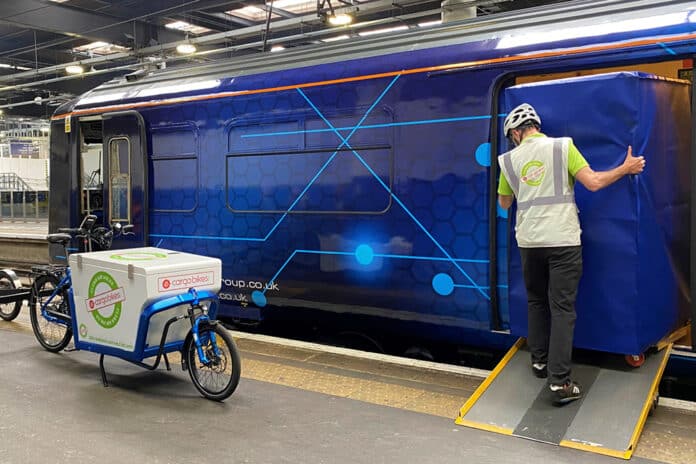High-speed parcel deliveries will soon be made by rail to satisfy a growing demand for faster freight.
Network Rail and distribution firm Orion have showed how the concept works at Euston station.
Former passenger trains are being converted to take goods directly into city centre stations.
As well as online retail, the flexible freight operation could transport other light goods needed in super-fast time by businesses.
Parcels would then see bicycle or van couriers take them for final delivery.
The trains can travel up to 100mph – twice the average speed as road traffic. As well as faster delivery times, the converted trains:
- Are cleaner than air and road haulage
- Can access city centres unlike larger scale rail freight or air
- Can operate on electrified and non-electrified rail
- Are easy to load and unload onto modes of transport for first and last mile of the journey*
Daniel Fredriksson, Network Rail customer relationship executive, said: “We’re excited to show what future uses rail has for distribution using Euston as a test site given its important history as a mail rail hub. While parcel trains are by no means a novel concept, more of us buying things online and efforts to get polluting vehicles off roads is revitalising rail as a cost effective and fast way to get goods to consumers and businesses quickly and efficiently.
“Network Rail has been working with Orion as it’s repurposing former passenger trains to serve this new purpose, while opening up the opportunities this has for economic growth as the country emerges from the coronavirus pandemic.”
Karl Watts, chief executive officer for Orion, said: “Orion High Speed Logistics represents a revolution in the way we deliver goods into city centres. Using converted, electrically powered passenger trains, Orion is able to deliver goods into terminal and other principal railway stations where electric road vehicles complete the final mile transportation into city centres.
“The shift from road to rail transportation delivers economic, environmental and social benefits. Each 8-car train removes 24 diesel powered vans from our roads thereby reducing congestion, lowering carbon emissions and improving inner city air quality.”
Rail Minister, Chris Heaton-Harris MP, said: “It is really positive to see companies exploring innovative methods like this to transport rail freight. Repurposing former passenger trains will allow light goods to travel to consumers in a faster and greener way, helping to decarbonise our railway, reduce congestion on our roads, and support growth in the rail freight market.
“Through our reforms in the Williams Shapps Plan for Rail we are committed to unlocking the economic and environmental benefits rail freight can deliver, as we look to level up the country and build back greener.”
Some of the UK’s largest parcel carriers have expressed interest in using the new high-speed logistics service using the converted trains.
The first will start running later this year between the Midlands and Scotland.
More routes could be added in 2022 dependent on customer need and available train paths.
* How does the train work?
- Class 319 passenger train which has been converted to a class 769.
- Can run up to speeds of 100mph
- It is now a bi-mode train with diesel engines which allows it to use both electrified and non-electrified rail.
- Operates in formation of 4 so that’s 4/8/12 carriages.
- Inside of the train has been fully re-fitted for logistics use, it can accommodate roll cages, pallets and other customer identified vessels or containers.
- 1 carriage can fit approximately the same amount of goods as 1 articulated lorry.
Photo and video credit: Orion



































 0113 2082620
0113 2082620 info@railbusinessdaily.com
info@railbusinessdaily.com 15 Mariner Court, Wakefield WF4 3FL
15 Mariner Court, Wakefield WF4 3FL

